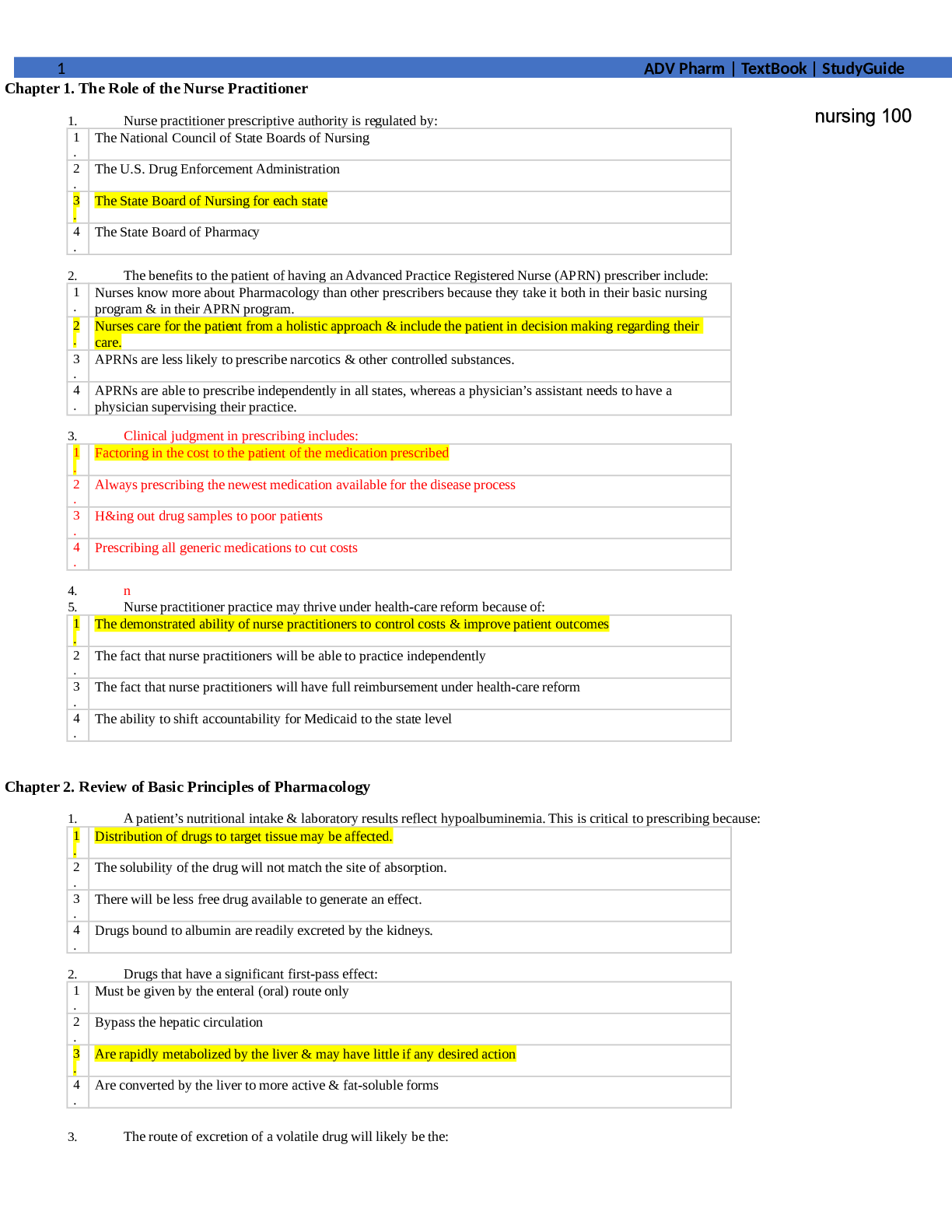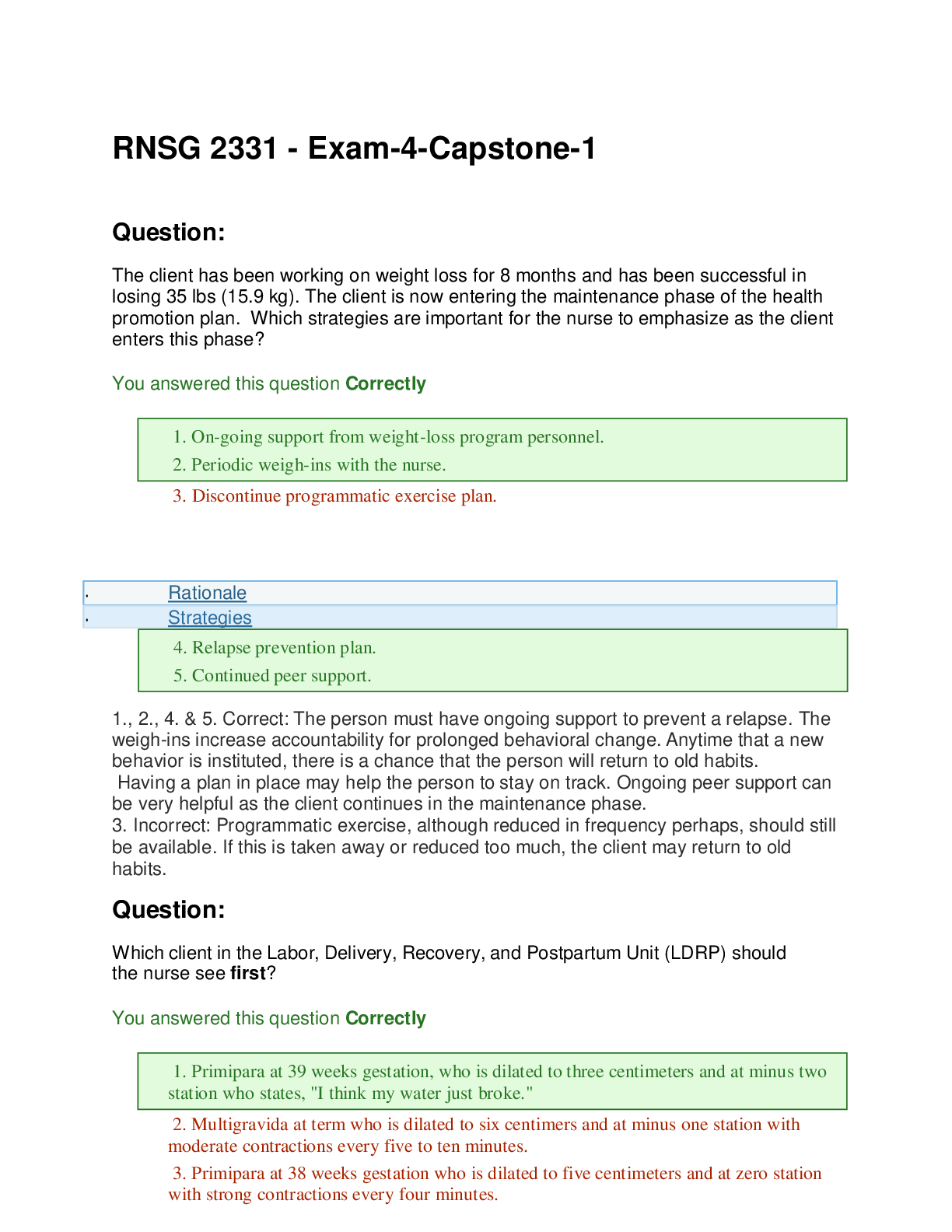*NURSING > QUESTIONS & ANSWERS > CPT & HCPCS Coding CH 3 Evaluation & Management flashcards Questions and Answers Already Passed (All)
CPT & HCPCS Coding CH 3 Evaluation & Management flashcards Questions and Answers Already Passed
Document Content and Description Below
CPT & HCPCS Coding CH 3 Evaluation & Management flashcards Questions and Answers Already Passed ROS is an acronym for what? Correct Answer-review of systems Enter the number of levels of service t... here are for initial hospital care codes? (Please enter the number, not the verbiage for the number.) Correct Answer-3 Enter the number for how many hospital discharge codes there are. (Please enter the number, not the verbiage for the number.) Correct Answer-2 Name two things that could be considered social history. Correct Answer-Answers include: drug and alcohol use, smoker, occupation, marital status, sexual or drug history, etc. What makes a patient a "new" patient vs an "established" patient. Correct Answer-NEW patient has NOT been seen by any provider in the practice for three years. An ESTABLISHED patient has been seen by a provider in the practice in the past three years. A new patient has NOT been seen by any provider in the practice for three years. The time frame is very important. Seven vital signs make up constitutional for an exam. Name three. Correct Answer-temperature, pulse, respiration, blood pressure supine, blood pressure sitting or standing, height, and weight Yes or no, does a patient have to be admitted tot he ICU to bill critical care? Correct Answer-no Name ONE of the "three R's" for consultation coding and billing. Correct Answer-request, render an opinion, and report back to the requesting providerTime is considered a key factor when determining level of service when 50% of the physician time is spent doing what? Correct Answer-counseling Name 3 of the 7 components that make up E and M codes. Correct Answer-history, exam, medical decision making, counseling, coordination of care, nature of presenting problem, and time T/F After a patient is evaluated, a management plan is implemented and recorded in the medical facility. Correct Answer-true T/F a new patient is one who has not received face to face care from their provider within 2 years. Correct Answer-false- 3 yrs T/F there are seven key components to choosing a level of E/M service. Correct Answer-false-There are only three/3 KEY components: history, exam, and medical decision making. T/F The lowest level of code for an office visit when you are charging for a problem focused new patient visit is code 99211. Correct Answer-false T/F The ROS is the part of the note in which the provider documents any body system(s) that might be affected by the chief complaint. Correct Answer-fasle T/F when time is used as a key component in billing an E/M service, the provider must document face to face time with the patient and how much time was spent counseling the patient with the family. Correct Answer-true T/Fan incorrect place of service can result in a rejection by insurance carriers. Correct Answer-true T/F a 99233 is coded for a high level initial hospital care visit. Correct Answer-false T/F to code a preventative physical exam, the coder first must determine the level of history the provider has recorded. Correct Answer-false T/F The POS for an office visit is 23 Correct Answer-false the _______ is the location whre care was rendered. Correct Answer-POS ____________ services are services provided to a patient who is presenting for a well visit. Correct Answer-preventative medicine critical care codes are _____ based. Correct Answer-time codes ______ are used when a patient is admitted and discharged on the same date of service. Correct Answer-99234-99236 ________ a patient and/or family member usually involves treatment options and instruction on medicine. Correct Answer-counsleing a patient who has NOT received face to face services from a provider of the same specialty within the same group practice would be considered a(n) _______ patient. Correct Answer-new a patient who has received face to face services from a provider of the same specialty within the same group practice would be considered a(n) _______ patient. Correct Answer-establisheda(n) _______ is a service rendered by a provider when his or her opinion or expertise is requested by another provider or appropriate source. Correct Answer-consultation an organized hospital based facility that renders unscheduled episodic services to patients who require immediate attention is know as a(n) Correct Answer-emergency department (ED) for services to a neonate in the intensive care unit to be coded with a 99479, the birth weight of the infant must fall between ______ and _____ Correct Answer-1500 and 2500 grams CH 3 CASE STUDY 1 Mrs. Edison was having trouble eating some of the foods the nutritionists had set up on her diabetic diet menu. Mrs. Edison talked with the nutritionist, who in turn called the doctor overseeing Mrs. Edison's care. The doctor and the nutritionist were on the phone, had a lengthy phone conversation, and decided to integrate a new menu that both of them felt would be more beneficial to Mrs. Edison and management of her diabetes. The doctor decided to bill for the telephone call even though the information discussed was not complex in nature, details had to be worked out, and a change to the care plan was necessary. The call length is 24 minutes. CPT code(s): _______ Correct Answer-Case 1—99443 Rationale: Phone call was initiated by the patient and was not the result of the recent visit with the doctor. Time was calculated at 24 minute CH 3 CASE STUDY 2 Daisy, a 10-year-old girl, was very sick when she presented for an office visit at her pediatrician's office. She was running a high fever, was very lethargic, had swollen glands, and showed signs of dehydration because of the vomiting she had been doing the previous night. The doctor decided, after a comprehensive history and physical, that Daisy needed to be admitted to the hospital for lab workup, rehydration, antibiotics, and monitoring. Daisy's pediatrician stopped in to the hospital that evening to evaluate her condition and check on lab results. CPT code(s): ____________ Correct Answer-Case 2— 99223 Rationale: Hospital admission includes all work done in the office on the same date of service as the admission CH 3 CASE STUDY 3Colin was having great difficulty living alone since his recent fall down the back steps of his house. His family decided that Colin should move to a skilled nursing facility (SNF), which he finally agreed to do. The physician at the SNF did a comprehensive history and physical. The medical decision making was of moderate complexity, and there was a very detailed plan of care implemented which would work on building Colin's strength and re-teaching him how to get around in a safer manner. CPT code(s): ___________ Correct Answer-Case 3—99305 Rationale: Initial nursing care facility encounter where a comprehensive history and comprehensive physical was performed. Medical decision making was of moderate complexity. CH 3 CASE STUDY 4 Nick was riding his dirt bike and collided with a tree. The EMTs stabilized Nick at the scene and transported him to the nearest hospital. His doctor, Dr. Shanequa, had been contacted by the family and would meet them at the hospital emergency room. In the emergency room, Dr. Shanequa took a detailed history, did a comprehensive physical, and ordered lab work and x-rays of the head, neck, and back, along with the right leg, because Nick was complaining of severe pain in the lower portion of the leg. Dr. Shanequa determined that although Nick was pretty banged up and should not ride the dirt bike for a while, he was fine. The x-rays showed a bad sprain in the ankle area, but nothing was broken. (Hint: Keep in mind that Dr. Shanequa is Nick's primary care physician and not the ED doctor.) CPT code(s): __________ Correct Answer-Case 4—99214 Rationale: The key components support the level of service performed. Dr. Shanequa is not an emergency department physician, so he would not be billing the emergency department codes (99281-99285). The emergency department is considered outpatient. CH 3 CASE STUDY 5 Megan was admitted to the hospital on May 31 at 5:00 a.m. for chest pain with nausea and heartburn. A comprehensive history was taken, and a comprehensive exam was done. Twelve hours later, after labs, xrays, and monitoring had been completed, and with no repeat in symptoms, it was determined that Megan had suffered a bout of GERD, and she was released to go home. CPT code(s): __________ Correct Answer-Case 5—99235 Rationale: Admission and discharge were performed on the same date, May 31; so this code would be the appropriate assignment for this scenarioCH 3 CASE STUDY 6 Skilled Nursing Facility Discharge Summary This 83-year-old has been a resident for the past 1½ years. She was admitted because she had polio with left hemiparesis with speech impediment. She was hospitalized 4 months ago with an exacerabation of COPD, dehydration, and low blood pressure. After physical, speech, and occupational therapy, the patient has now become more independent and is able to walk behind her wheelchair. She is able to perform all of her ADLs. Routine lab work was completed last week and was found to be within normal ranges. The patient is being discharged to her daughter's home. Final examination of Patient The patient is alert. Vital signs: BP 120/66, P-64, R-12 weight -1 65 lb. HEENT: Head- normocephalic EENT: clear. NECK: No lymphadenopathy or thyromegaly. LUNGS: Clear, good air entry. HEART: Regular rhythm, no murmurs. Distal pulses palpable. ABDOMEN: Soft, nondistended. NEUROLOGICAL: Cranial nerves 2-12 grossly intact except for speech impediment. Has left hemiparesis. Discharge records were completed and instructions, and prescriptions were given to the patient's daughter. CPT code(s): ______________ Correct Answer-Case 6—99315 Rationale: The service completed was a discharge summary and because no time was recorded; the lowerlevel discharge summary code is selected. CH 3 CASE STUDY 7 this patient has been a patient of mine for six years, and I saw him three months ago fro his annual physical. Today he presents with a cough for the last two days with a fever of 101 and is short of breath (SOB). Personal medial history is significant for appendicitis in 2003. this well nourished, well developed 25 year old patient presents with a cough and fever. BP 120/70. Height: 5 feet 9 inches. Weight: 175 lb [Show More]
Last updated: 2 years ago
Preview 1 out of 13 pages

Buy this document to get the full access instantly
Instant Download Access after purchase
Buy NowInstant download
We Accept:

Reviews( 0 )
$8.00
Can't find what you want? Try our AI powered Search
Document information
Connected school, study & course
About the document
Uploaded On
Sep 11, 2022
Number of pages
13
Written in
Seller

Reviews Received
Additional information
This document has been written for:
Uploaded
Sep 11, 2022
Downloads
0
Views
413



















.png)



.png)

